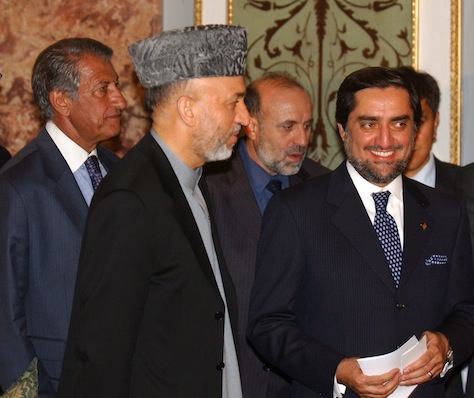In what must be one of the world’s slowest vote-counting exercises, most of the results of Afghanistan’s April 5 election have now been tallied, and frontrunner Abdullah Abdullah’s lead is growing in his bid to succeed outgoing president Hamid Karzai.![]()
With around 82% of the votes now counted, Abdullah leads with 43.8%, followed by Ashram Ghani Ahmadzai, a former World Bank official and finance minister, who is winning 32.9%. Zalmai Rassoul, until recently Karzai’s foreign minister, was in third place with 11.1%.
Though Abdullah’s lead has grown steadily throughout the vote count, he won’t achieve the absolute majority he would otherwise need to avoid a runoff against Ghani, which would take place after May 28 — likely in June.
* * * * *
RELATED: Afghanistan hopes for calm as key presidential election approaches
* * * * *
A report in The New York Times over the weekend indicated, however, that Abdullah (pictured above with Karzai in 2004) is already on the verge of winning Rassoul’s support, which could power Abdullah to a convincing runoff victory against Ghani by bringing southern Pashtun tribes close to Karzai into his ethnic and political coalition. Though the outgoing president hasn’t endorsed a candidate in the race, Rassoul is widely seen as the candidate of the Karzai administration, and Karzai’s brother, Quayum Karzai, dropped out of the race in March and endorsed Rassoul.
In the meanwhile, despite some horrific violence in the weeks leading up to the election, the Taliban, which is boycotting the vote, has been remarkably quiet, notwithstanding expectations that it would be working hard to undermine safety during the election campaign. Some analysts believe that the Taliban is waiting until the runoff vote to achieve maximum disruption, but the lull might actually mean that Abdullah and Ghani and their supporters are negotiating behind the scenes with key Taliban leaders.
So what does this mean for Afghanistan — and for the US military presence there?
The sooner that a runoff is held, the sooner that Afghanistan’s new president will be able to turn to negotiating an agreement with the United States over its possible peacekeeping and security role after the end of this year, when most US and other NATO military personnel will leave Afghanistan after a 13-year force that initially ousted the Taliban from power in November 2001.
While Karzai has increasingly clashed with the US government, especially during the administration of US president Barack Obama, both Abdullah and Ghani favor a status-of-forces agreement that contemplates an ongoing security role for US personnel — unlike in Iraq, where the Obama administration and Iraqi prime minister Nouri al-Maliki failed to agree the terms, and the United States has zero military presence in a country that it occupied between 2003 and 2011 and that remains fraught with sectarian tension and violence.
While both Abdullah and Ghani have pledged to take a strong line against the Taliban-led insurgency, they will both almost certainly work to bring the Taliban into negotiations in the future to provide greater security throughout Afghanistan.
By and large, the US government and the international community would welcome either Abdullah or Ghani as Afghanistan’s next president. In addition to their broad support for an orderly agreement for US security help, both candidates have wide experience internationally, though Ghani, who lived and worked in the United States for decades and who was a candidate in 2006 to become the secretary-general of the United Nations, has the stronger international resume.
But Abdullah has more experience on the ground in Afghanistan, going back to his efforts as a deputy foreign minster in the ill-fated government of Burhanuddin Rabbani between 1992 and 1996, his role as one of the few English-speaking spokespersons for the Northern Alliance between 1996 and 2001, and in his role working with Karzai in the first four years of post-Taliban government.
Abdullah emerged, however, as Karzai’s chief opponent in the 2009 presidential election, a fraud-ridden disaster. Though the United States and other actors pushed Karzai into accepting a runoff against Abdullah, the process was so obviously flawed that Abdullah refused to take part, essentially ceding victory to Karzai. This time around, however, the voting seems to have gone more smoothly amid much higher turnout than in 2009.
Abdullah, 53, is half Pashtun and half Tajik, giving him a leg up in the both communities. Pashtuns comprise around 42% of the Afghan population, and almost all of its ruling elite have been Pashtun, including the former Afghan royal family, Karzai and Taliban leaders. But the Tajik, which comprise another 27% of the population (and they form around 45% of the population in Kabul, the Afghan capital), dominate Afghanistan’s northeast, and they played a chief role within the Northern Alliance that swept the Taliban from power in 2001. Abdullah had longtime ties to Ahmad Shah Massoud, the leading figure in the Northern Alliance until his assassination in September 2001.
Abdullah’s two running mates are Mohammad Khan, a former leader of Hezb-i-Islami, another Pashtun insurgent group that has been responsible for suicide bombings and other political violence in the past, and Mohammad Mohaqiq, a leader within the Hazara community. The Abdullah-Khan alliance might ease what will be a priority for the next Afghan administration — a negotiation to end the Taliban counterinsurgency.
Ghani, who has allied with one of the Uzbek community’s top warlords, draws his support from both the Pashtun and the Uzbek ethnic groups.
